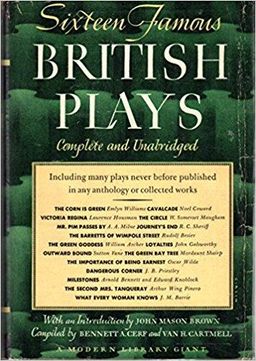Sixteen Famous British Plays
Bennett A. CerfSixteen Famous British Plays Hakkında
Sixteen Famous British Plays konusu, istatistikler, fiyatları ve daha fazlası burada.Hakkında
Yazar: Bennett A. Cerf
Yazar: Van Cartmell
Tahmini Okuma Süresi: 28 sa. 20 dk.Sayfa Sayısı: 1000Basım Tarihi: 1943Yayınevi: Random HouseOrijinal Adı: İngilizceISBN: ---Ülke: TürkiyeDil: TürkçeFormat: Karton kapak
Türler:
Yazar Hakkında
Bennett A. CerfYazar · 1 kitap
Bennett Cerf was born on May 25, 1898, in Manhattan, New York, to a Jewish family of Alsatian and German origin.[1][2][3] Cerf's father Gustave Cerf was a lithographer; his mother Frederika Wise was heiress to a tobacco-distribution fortune. She died when Bennett was fifteen; shortly afterward, her brother Herbert moved into the Cerf household and became a strong literary and social influence on the teenager.[4]
Cerf attended Townsend Harris High School, the same public school as publisher Richard Simon and playwright Howard Dietz. He spent his teenage years at 790 Riverside Drive, an apartment building in Washington Heights that was home to two friends who became prominent as adults: Howard Dietz and Hearst newspapers financial editor Merryle Rukeyser. He received his Bachelor of Arts from Columbia College of Columbia University (1919) and his Litt.B. (1920) from its School of Journalism. After graduation, he briefly worked as a reporter for the New York Herald Tribune and for some time in a Wall Street brokerage. He then was named a vice-president of the publishing firm Boni & Liveright.
In 1925, Cerf and Donald S. Klopfer formed a partnership to purchase the rights to the Modern Library from Boni & Liveright, and they went into business for themselves. They increased the popularity of the series and, in 1927, they began publishing general trade books which they had selected "at random." This began their publishing business, which in time they named Random House. It used as its logo a little house drawn by Cerf's friend and fellow Columbia alumnus Rockwell Kent.[5]
Cerf's talent in building and maintaining relationships brought contracts with such writers as William Faulkner, John O'Hara, Eugene O'Neill, James Michener, Truman Capote, Theodor Seuss Geisel, and others. He published Atlas Shrugged, written by Ayn Rand, even though he vehemently disagreed with her philosophy of Objectivism. He admired her "sincerity" and "brillian[ce]," and the two became lifelong friends.[6][7]
In 1933, Cerf won United States v. One Book Called Ulysses, a landmark court case against government censorship, and thereafter he published James Joyce's unabridged Ulysses for the first time in the United States. (One chapter had been published in Margaret Anderson's and Jane Heap's The Little Review, a Chicago-based literary magazine, which had led to its being found "a work of obscenity.") In 1933, Random House had the rights to publish the book in the United States, and they arranged for a test case to challenge the implicit ban so as to publish the work without fear of prosecution. The publisher therefore made an arrangement to import the French edition of the book and to have a copy seized by the United States Customs Service when the ship arrived carrying the work. Despite advance warning to Customs of the anticipated arrival of the book, the local official declined to confiscate it, stating that "everybody brings that in." He and his superior were finally convinced to seize the work. The United States Attorney then took seven months before deciding whether to proceed further. The Assistant U.S. Attorney assigned to assess the work's obscenity felt that it was a "literary masterpiece"—yet he also found it obscene within the meaning of the law. The office, therefore, decided to take action against the work under the provisions of the Tariff Act of 1930, which allowed a district attorney to bring action. Cerf later presented the French-language book to Columbia University.[8]
In 1944, Cerf published the first of his collection of joke books Try and Stop Me, with illustrations drawn by Carl Rose. A second book Shake Well Before Using was published in 1949. It was at this time that he became a member of the Peabody Awards Board of Jurors, serving from 1946 through 1967, then returning to the board from 1970 to 1971. Additionally, he served as Chair Juror of the Peabody Jurors Board from 1954 to the end of his first term in 1967 and published a weekly column titled "The Cerf Board," in the Sunday supplement magazine This Week.[9]
In the early 1950s, while maintaining a Manhattan residence, Cerf bought an estate at Mount Kisco, New York, which became his country home for the rest of his life. A Mount Kisco street named Cerf Lane runs from Croton Avenue and is named after him. Cerf married actress Sylvia Sidney on October 1, 1935; they divorced six months later on April 9, 1936. He married Hollywood actress Phyllis Fraser, a cousin of Ginger Rogers, on September 17, 1940. They had two sons, Christopher and Jonathan.
In 1959, Maco Magazine Corporation published what became known as "The Cream of the Master's Crop," a compilation of Cerf's jokes, gags, stories, puns, and wit.

